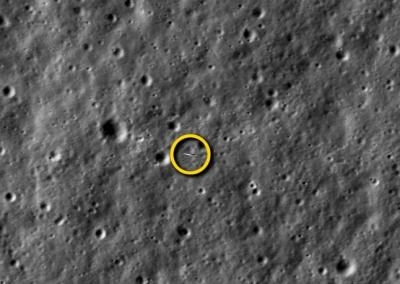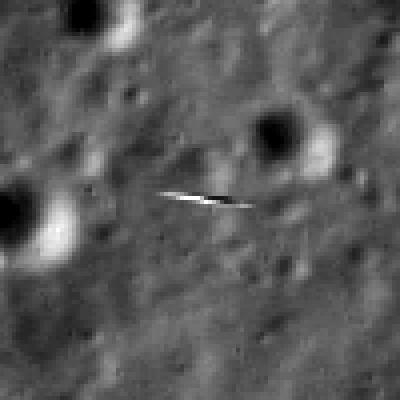Mon, Feb 03, 2014
Each Spacecraft Orbiting The Moon At 3,600 Miles Per Hour
With precise timing, the camera aboard NASA's Lunar Reconnaissance Orbiter (LRO) was able to take a picture of NASA's Lunar Atmosphere and Dust Environment Explorer (LADEE) spacecraft as it orbited our nearest celestial neighbor. The Lunar Reconnaissance Orbiter Camera (LROC) operations team worked with its LADEE and LRO operations counterparts to make the imaging possible.

LADEE is in an equatorial orbit (east-to-west) while LRO is in a polar orbit (south-to-north). The two spacecraft are occasionally very close and on Jan. 15, 2014, the two came within 5.6 miles of each other. As LROC is a push-broom imager, it builds up an image one line at a time, so catching a target as small and fast as LADEE is tricky. Both spacecraft are orbiting the moon with velocities near 3,600 mph, so timing and pointing of LRO must be nearly perfect to capture LADEE in an LROC image.
LADEE passed directly beneath the LRO orbit plane a few seconds before LRO crossed the LADEE orbit plane, meaning a straight down LROC image would have just missed LADEE. The LADEE and LRO teams worked out the solution: simply have LRO roll 34 degrees to the west so the LROC detector (one line) would be in the right place as LADEE passed beneath.
As planned at 2211 EST on Jan. 14, 2014, LADEE entered LRO’s Narrow Angle Camera (NAC) field of view for 1.35 milliseconds and a smeared image of LADEE was snapped. LADEE appears in four lines of the LROC image, and is distorted right-to-left. What can be seen in the LADEE pixels in the NAC image?

Step one is to minimize the geometric distortion in the smeared lines that show the spacecraft. However, in doing so the background lunar landscape becomes distorted and unrecognizable. The scale (dimension) of the NAC pixels recording LADEE is 3.5 inches, however, as the spacecraft were both moving about 3,600 mph the image is blurred in both directions by around 20 inches. So the actual pixel scale lies somewhere between 3.5 inches and 20 inches. Despite the blur it is possible to find details of the spacecraft, which is about 4.7 feet wide and 7.7 feet long. The engine nozzle, bright solar panel and perhaps a star tracker camera can be seen, especially if you have a correctly oriented schematic diagram of LADEE for comparison.
(Images provided by NASA. Comparison schematic not available)
More News
Circle To Runway (Runway Number) Used by ATC to inform the pilot that he/she must circle to land because the runway in use is other than the runway aligned with the instrument appr>[...]
Aero Linx: National Aviation Safety Foundation (NASF) The National Aviation Safety Foundation is a support group whose objective is to enhance aviation safety through educational p>[...]
At Altitude Of About 250-300 Ft Agl, The Airplane Experienced A Total Loss Of Engine Power On November 6, 2024, at 1600 central standard time, a De Havilland DHC-1, N420TD, was inv>[...]
From 2009 (YouTube Edition): Three Hour Flight Was 'Flawless' -- At Least, Until Mother Nature Intervened For anyone who loves the aviation business, this was a VERY good day. Afte>[...]
Also: AMA Names Tyler Dobbs, More Falcon 9 Ops, Firefly Launch Unsuccessful, Autonomous F-16s The Air Force has begun ground testing a future uncrewed jet design in a milestone tow>[...]
 ANN's Daily Aero-Term (05.05.25): Circle To Runway (Runway Number)
ANN's Daily Aero-Term (05.05.25): Circle To Runway (Runway Number) ANN's Daily Aero-Linx (05.05.25)
ANN's Daily Aero-Linx (05.05.25) NTSB Prelim: De Havilland DHC-1
NTSB Prelim: De Havilland DHC-1 Classic Aero-TV: The Boeing Dreamliner -- Historic First Flight Coverage
Classic Aero-TV: The Boeing Dreamliner -- Historic First Flight Coverage Airborne-NextGen 05.06.25: AF Uncrewed Fighters, Drones v Planes, Joby Crew Test
Airborne-NextGen 05.06.25: AF Uncrewed Fighters, Drones v Planes, Joby Crew Test




